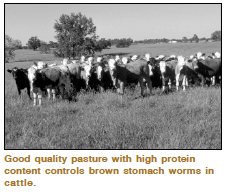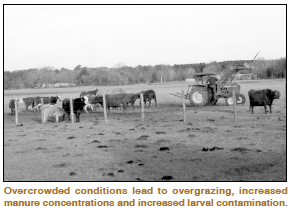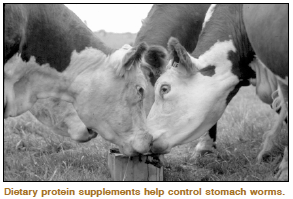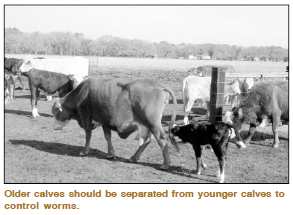Download PDF | Email for Questions
Protein deficient cattle have a low immunity against stomach worms. However, proper diet and pasture management can result in the control of brown stomach worms without the use of deworming drugs.
Cattle can be protein deficient if they graze pastures low in protein or if they are overgrazed on pastures adequate in protein. Low protein intake results in low protein levels in blood and tissues and a suitable environment in the stomach for worms.
Overcrowding and overgrazing pasture lead to poor nutrition of cattle and to poor sanitation. Excess manure and worm larvae contaminate the pasture. Rain is needed to wash the larvae from the manure onto pasture where they can be ingested by cattle. Weekly rains and moderate temperatures increase the risk that cattle will become infected with worms by grazing contaminated grass wet from rain or dew. Dry weather decreases pasture contamination and the transmission of worm larvae is reduced.
The most important way to control worms in grazing cattle is to maintain good nutrition practices. The rate of infection can be reduced by preventing exposure to heavy levels of larvae on the grass and by interfering with the establishment of larvae and adult worms in the stomachs of cattle.

Begin a worm control program by improving the nutritional condition of cattle as winter ends. Cattle have lost their aging worm infection from the previous fall exposures and are not reinfected during the winter, while the soil temperature is below 55 degrees F and larvae are hibernating. As soil temperatures rise, the larvae on the contaminated pasture become active. Protein deficient cattle become infected with overwintered larvae by grazing contaminated, wet grass in early spring. Then, worm eggs passed in their manure become a continual source of pasture contamination during the spring if weekly rains occur to wash the larvae from manure. To ensure cattle maintain noneconomic, low levels of brown stomach worms, feed a protein supplement during late winter and early spring to fortify the cattle’s diet of hay and /or grass. When the spring grass emerges and haying stops, do not overcrowd cattle and overgraze pasture.
If manure piles on the pasture are difficult to find, there is probably a low contamination level of larvae in the pasture. Conduct soil tests and fertilize pastures as needed to maintain adequate protein and grass growth throughout the grazing season.
Cattle on overcrowded pastures should be fed hay and supplements during the spring. If manure on the pasture is easy to find, there is probably a high contamination level of larvae. Use a drag implement to break up dense manure piles on the pasture. Breaking up manure when there is no rain helps dry and kill larvae before they can be washed by rain from manure and contaminate wet grass.

Give pasture a rest to relieve the grazing pressure of cattle on grass. Divide the pasture into four cell pastures. Rotate the cattle every week to allow 3 weeks of uninterrupted grass growth in each cell. A high percentage of worm larvae die during the resting of a cell pasture. Infective larvae, if not swallowed by cattle within a few weeks, will die from starvation or from drying. Grazing of a cell for 1 week does not provide enough time for worm eggs in fresh manure to hatch and develop into infective larvae. Therefore, concentrated cell grazing for 1 week does not increase exposure of cattle to worms.
As ingested larvae of brown stomach worms invade the cattle’s stomach linings, an immunity against the worms in healthy cattle is stimulated. Repeated low exposures to larvae boost the level of immunity. High immunity in cattle interferes with the invasion of infective larvae and reduces the egg-laying ability and life span of adult worms.
In late summer, cattle lose their aging adult worm infections acquired from the previous spring exposures. They are not exposed to pasture larvae during July and August because, during times of no rain, larvae on the pasture die from dryness and heat. Also, during dry weather, manure piles dry, creating a crust that inhibits larvae from being washed out by rain, and the larvae die from dryness and bacterial decay.
Maintain normal protein and immunity levels of cattle during August and September by feeding hay and supplements to cattle grazing short, summer pasture. Continue the feeding during the fall if the growth of summer grass is not boosted by fall rains.
However, in the fall, the infection cycle begins again. Larvae swallowed in June and inhibited in cattle’s stomach linings will emerge and mature into adult worms in September as cattle’s immunity decreases because of protein deficiencies. High immunity in supplemented cattle interferes with the emergence of inhibited larvae. This results in less damage to cattle’s stomach linings and a reduced adult worm population. Eggs from these reduced numbers of adult worms are passed in the cattle’s manure and become a source of pasture contamination during the fall.

Repeated exposures to larvae on the grass only occur when weekly rains wash the larvae from the manure. Larvae remain active until the soil temperature drops below 55 degrees F. Then, the larvae hibernate on the pasture during the winter.
To kill larvae on a contaminated fall pasture, disk the soil and plant a small grain or ryegrass for winter grazing. Worm infections in cattle grazing winter planted pasture are stopped because of the soil cultivation, cold soil temperatures and high protein diet.
To reduce worm exposure to young nursing calves, maintain a 2-month calving period for a cow herd grazing a single pasture. When the calving period is in the fall, nursing calves can be weaned and removed from the cow herd before the high risk of exposure to pasture larvae in the spring.
Calves and young cattle are more susceptible to worms and pass more eggs in their manure than adult cattle. Older nursing calves are a major source of pasture contamination. Young nursing calves have a higher risk of becoming infected with worms when they occupy the same pasture with older nursing calves.
Separate young cattle from the cow herd. Not only is the cow herd pasture a possible source of infection to them, but they are source of pasture contamination for nursing calves. Separate replacement heifers from the cow herd until their second calving is the same 2- month calving period as the cow herd.

Extreme cold and hot temperatures, as well as lack of rain, control the transmission of the brown stomach worm. Control by management works well for grazing cattle in high risk areas with periodic rains, soil temperatures between 55 degrees to 85 degrees F, and larval activity during the spring, fall and warm winter. Regardless of pasture management, worms occur in greater frequency in cattle in high rainfall areas than in cattle under the same type of management in low rainfall areas.
To reduce rates of contamination to pastures, prevent overcrowding and separate cattle by age groups. If cattle are exposed, infections can be killed by increasing immunity of cattle by ensuring proper nutrition, which also causes the environment of the cattle’s stomachs to be unsuitable for worm development. If these management practices are followed, then the use of deworming drugs in cattle is not necessary, nor economical.
